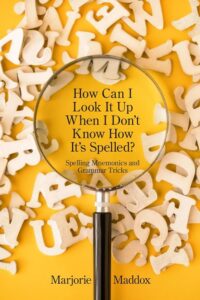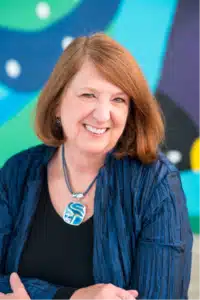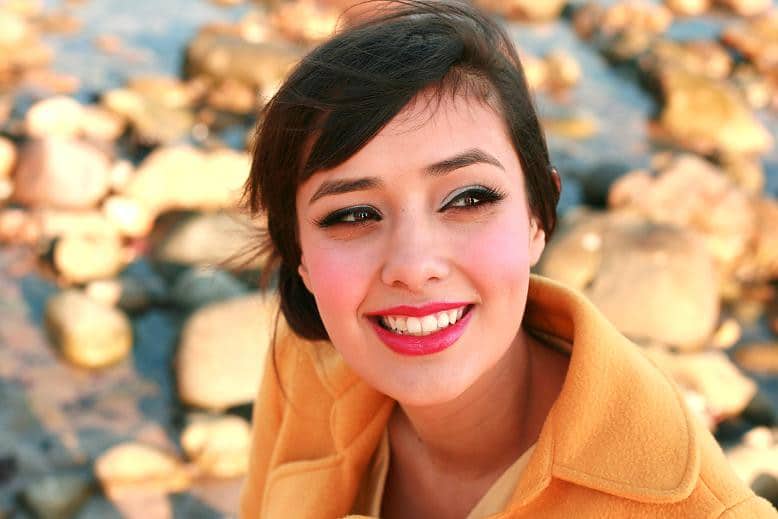Marjorie Maddox Hafer pairs poetry with art and spelling lessons.
In 2018, poet Marjorie Maddox Hafer drove with her then art-student daughter Anna Hafer to Baltimore. Their destination was the American Visionary Art Museum. As Hafer describes in her introduction to In the Museum of My Daughter’s Mind (2023), they drove through a thunderstorm, and the poet herself was recovering from a recent medical procedure.
At the museum they walked into both poetic and artistic inspiration. Hafer would write nine poems based on art and photography works on view there; within a year, her daughter would receive her art degree, hold her first exhibition, and sell her first work. Hafer includes the nine poems in this 2023 collection, accompanied by the inspirational artworks themselves. The other 23 poems in the collection are matched to works by her daughter. (You can see many of Anna Hafer’s art works here.)
The term ekphrasis, or “description” in Greek, is used to define poems about works of art. Hafer often goes beyond description as she moves through her daughter’s art works as well as the museum’s exhibits. The poems come to define the works and explain them, amplifying the visual meaning. The collection is physically stunning; it won first place in fine arts / photography from the Royal Dragonfly Book Award and was the American Book Fest’s American Fiction Award Winner for General Poetry.
One of the paintings by Anna Hafer is of a light bulb, which, as the caption notes, can suggest intelligence, faith, darkness, and light, among other concepts (I think of yelling “Eureka!”). Her mother incorporates several of the concepts into her accompanying poem.
Switch
—after the painting by Anna Lee Hafer

the brain, gets the action done.
Or a noun—off/on, dark/bright
with what it knows. Verb recites
each epiphany brilliantly. Never outdone,
Switch is a verb that lights
location, flicks on insights
to illuminate in-/exteriors. The lone
lamp of noun—on/off, dark/bright—
it shines meaning, switches day and night,
distinctions cited. It recognizes its own
and acts. Switch is a verb that lights
the foggy brain. Its decisions brighten
dim rooms with up not down.
As noun, the off/on word knows dark/bright
but waits while Verb chooses what’s right.
Shrouded in shadow, Noun’s tone
is passive. Switch: best as verb that lights
up noun: off into on, dark into bright.
In the Museum of My Daughter’s Mind is a beautiful book, a work of visual and poetic art in itself that moves the reader from seeing and reading to understanding.
Earlier this year, Hafer published another poetry collection, How Can I Look It Up When I Don’t Know How It’s Spelled? Spelling Mnemonics and Grammar Tricks. The title tells you exactly what the 20 poems are about – spelling and how to learn some of the rules for spelling English words. It helps to remember that Hafer is a professor of English and Creative Writing. In fact, she dedicates the collection to her students and “teachers everywhere who make learning fun.
This collection, too, makes full use of illustrations. Hafer was assisted by artist and former college English teacher Karen Elias, who drew upon her own work and clip art. Hafer and Elias had previously collaborated on Heart Speaks, Is Spoken For.
Do you sometimes misspell “separate”? Or stumble with how many of letter “s” there are in assassin? Or is it principle or principal, or when do you use I or me? Hafer has a poem for you, like she does for vowels.
When Two Vowels Go Walking,

cackles, gibbers, babbles,
mutters, sputters, splutters,
rattles, clatters, blathers all the way past Baker Street,
around the ballfield and back. It is usually the O,
her whole body a wind tunnel of what, who, why, where, and when
her neighbors are doing, thinking, saying.
It is easy to get caught in the whirl
as her arms aerobically push away with their weights
any oncoming interruption.
Best to take an iPhone and not listen.
The second, the A, too shy for assertiveness training,
left out of Friends and Family,
is resigned to the single scene. She simply walks.
Nodding acknowledgment at each step,
she is at home as audience,
her aphonia altogether alluring
to those mouthing the monologue.
The collection is great fun and – here is the point – helpful.

Marjorie Maddox Hafer
Hafer is the author of 12 previous poetry collections, including Nightrider to Edinburgh (1986), Body Parts (1999); Transplant, Transport, Transubstantiation (2004 and republished by Wipf and Stock Publishers); Weeknights at the Cathedral (2006); Local News from Someplace Else (2013); Perpendicular as I (1999 and 2013); True, False, None of the Above (2018); Heart Speaks, Is Spoken For (2022), and Begin with a Question (2022). She is the co-author of the anthology Common Wealth: Contemporary Poets on Pennsylvania (2005) and author of two children’s books, including Rules of the Game: Baseball Poems (2009). Hafer is a professor of English and Creative Writing at Lock Haven University in Pennsylvania.
Anna Hafer is an artist based in Philadelphia. A graduate of Roberts Wesleyan College in Rochester, New York, she’s exhibited her works at galleries in Rochester. Her art has also been published in several art and literary publications, including Still Points Art Quarterly, The MacGuffin, The Penn Review, and The Ekphrastic Review.
Elias taught college English for 40 years. She’s now an artist and uses photography to raise awareness of the natural world and climate change. She’s exhibited at several galleries and won numerous awards.
If you enjoy the interplay of art, photography, and poetry, then both In the Museum of My Daughter’s Mind and How Can I Look It Up When I Don’t Know How It’s Spelled? are made to order. English teachers will especially enjoy the collection on spelling.
Related:
Majorie Maddox Hafer Publishes 2 Poetry Collections.
Photo by xlorddashx, Creative Commons, via Flickr. Post by Glynn Young.
How to Read a Poem uses images like the mouse, the hive, the switch (from the Billy Collins poem)—to guide readers into new ways of understanding poems. Anthology included.
“I require all our incoming poetry students—in the MFA I direct—to buy and read this book.”
—Jeanetta Calhoun Mish
- Longfellow’s “Paul Revere’s Ride”: Creating a National Legend - April 17, 2025
- Poets and Poems: Katie Kalisz and “Flu Season” - April 15, 2025
- Poets and Poems: Michelle Ortega and “When You Ask Me, Why Paris?” - April 10, 2025


Marjorie Maddox says
Glynn, thank you for this very lovely double-review!